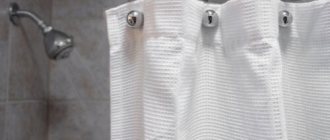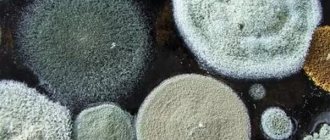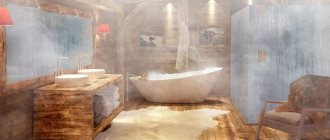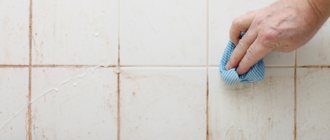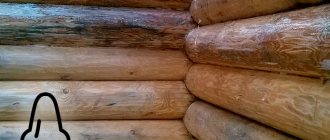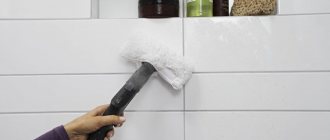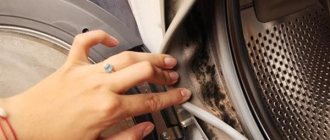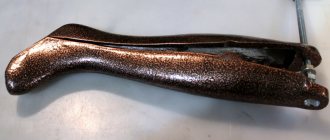Common Types of Mold
This is the name given to filamentous formations that form a single multicellular structure. Mold multiplies quickly, the main manifestations being stains on surfaces. Plaque of organic origin can have a different shade. The most dangerous types of mold:
Chaetomium globosum causes damage to wallpaper, window frames, books, and so on.
- Chaetomium globosum, or biodestructor. Found on coatings and things containing cellulose. Mold affects wallpaper, drywall, window frames, books, paintings, etc. At the initial stage, the fibers are characterized by a white color. Gradually the shade changes to olive with a gray undertone or black. This type of mold is most dangerous for people prone to developing allergies. Provokes the appearance of symptoms of asthma, rhinitis, and respiratory diseases.
- Cladosporium herbarum. Promotes the development of negative reactions in allergy sufferers and people not exposed to pathogenic particles. This type of mold is not always black in color. Colonies may be olive or brown in color. This is a type of mold that destroys various objects. It is found on any things, lining, etc. Other types of mold in this group: Chaetomium, Ulocladium, Aspergillus, etc.
- Blue fungus. Modifies surfaces - they acquire a characteristic color. The fungus develops in conditions of high humidity and affects objects made of coniferous wood. It can be found in private houses, rarely in an apartment.
Prevention measures
The best prevention for fungus is to keep it clean and away from moisture. It is necessary to install ventilation valves on double-glazed windows, and ventilation in bathrooms and kitchens. It is important to insulate frozen walls, and in a private house to equip a solid foundation and blind area. It is imperative to check the plumbing to ensure there are no leaks or breaks, otherwise fungus will inevitably settle in the bathroom.
If the air is too humid, even heating and installing an air conditioner to dry the air can help. Reduces the risk of mold by drying clothes on the balcony rather than in the apartment, regularly using a kitchen hood, and frequently cleaning areas where mold may appear with antiseptic agents.
Why is fungus on walls dangerous?
Not all species pose a threat to human health. For example, the fungus Wallemia from the black mold group is difficult to remove, but does not pose a danger. However, most varieties contribute to the development of allergies (at best). With prolonged contact with fungal spores, more severe complications arise: asthma, chronic bronchitis, skin diseases, pneumonia.
Fungus on the walls can cause various skin diseases.
Against the background of intoxication of the body, nausea, abdominal pain appear, and the functioning of the digestive tract and musculoskeletal system is disrupted. With prolonged contact with the most toxic types of fungi (for example, black mold), liver and lung function deteriorates. In the most severe cases, irreversible tissue changes occur and death is possible. The fungus poses a danger to people with reduced immunity: during the period of recovery from illness, while taking antibiotics, while undergoing chemotherapy.
Under the influence of mold, facing materials on walls, floors, and ceilings are destroyed. In this case, the coating is deformed: it swells, peels off, and its structure is disrupted. As a result, it is necessary to re-repair the premises and remove the finishing layer from the affected surfaces and adjacent areas.
If mold is in the bathroom for a long time, then it is more likely that it will penetrate quite deeply into the structure of the structure.
The longer mold has a destructive effect on a building material, the higher the likelihood that it will penetrate into the structure of the supporting structure to a significant depth. However, in most cases, it is possible to remove the fungus at the stage of its active development in the plaster layer. If the surface is not cleared of dark organic stains that have appeared in time, partial or complete destruction of the coating will soon occur.
Something about mold. The benefits and harms of mold
As you know, mold is a fungus; its spores are suspended in the air. When spores land on a surface favorable for reproduction (for example, on a damp wall), mold begins to grow very quickly - in just one day, a colony of mold fungi can increase 9 times.
Many people probably know that the first antibiotic that was used in medicine was penicillin. It was obtained from the mold penicillium (hence the name of the drug). The discovery of the antibacterial properties of mold helped save thousands of lives.
Due to its ability to suppress the vital activity of various microbes, mold has found its use not only in medicine, but also in the food industry. The use of certain types of mold for the preparation of various sausage products, as well as elite varieties of cheese, can significantly extend the shelf life of the final product. The widely known blue cheese is valued for its special delicate taste and aroma. The main thing is that when producing such food products, you need to strictly follow the technology, otherwise you may end up with a product with a colony of low-quality mold.
But mold is not always beneficial. Most often, it can significantly harm your health. Because mold spores easily penetrate the human lungs, it can cause respiratory diseases such as asthma and chronic bronchitis. Having settled on the skin and mucous tissues, the mold begins to irritate the surface, and severe itching may occur, including allergic reactions.
Mold can also cause more serious illnesses that can be fatal. There is evidence that its spores can cause leukemia. Liver cancer can be caused by highly toxic yellow mold, which can produce aflatoxin, which accumulates in the body over time. This type of mold can be found on foods rich in protein.
Molds that appear on surfaces that are too humid produce mycotoxins. They have an extremely negative impact on a person’s general condition - headaches, fatigue, indigestion, and decreased immunity. In the event of a serious immune system disorder, mold can begin to grow in the human body. This can lead to both allergic disease and serious lung damage. First of all, children, pregnant women and people who have weakened immunity as a result of various diseases can suffer from mold.
It's not just humans who suffer from the presence of mold. It affects and renders unusable a variety of surfaces - concrete, brick, wood, rubber, plastic, plastered.
It is impossible to completely get rid of the presence of mold spores in the air. The most important thing is to create conditions unsuitable for them to reproduce.
Mechanical method of removing fungus
One of the tools you will need to remove fungus mechanically is a spatula.
When black spots appear on the sealant in the joints between tiles in the bathroom or on the walls in living areas, the affected coating must first be removed. Different tools are used for this:
- putty knife;
- steel brush;
- grinding attachment (installed on the drill);
- sharp knife, etc.
To prevent the spread of spores through the air (the main method of contamination of surfaces), the cladding must be treated with water. To do this, it is recommended to use a spray bottle. If you use a sponge or rag, some of the spores will become airborne when the material comes into contact with the surface. When the fungus has already penetrated the structure of wood or concrete, the milling method is used. When the infection is severe, mold is also found on inorganic surfaces. If you plan to fight it yourself, it is important to follow the instructions:
- The surface is moistened with water from a spray bottle.
- They free load-bearing structures from cladding: wallpaper on the walls, whitewash on the ceiling, flooring. This will allow you to get to the mycelium.
- If it turns out that the mold has penetrated deeper into the structure of the material of the supporting structure, remove the layer of plaster. It is necessary to clean the wall down to the rough base - brickwork, concrete.
At the next stage, chemicals are used. However, if the preparatory work (mechanical cleaning) did not provide the required result, special means will not destroy the fungus. It will continue to develop on the adjacent site.
Chemical agents can also be used against fungus.
Causes and signs of mold
It is possible to eliminate moisture and determine how to get rid of mold on the walls in an apartment at home only after determining the type of mold.
. Fold spores develop only under conditions that include:
- high humidity and poor ventilation of the room;
- freezing of walls;
- Dampness;
- retractable roof or water pipes;
- insufficient heating.
Black, gray or white spots form on the walls, floor, ceiling or individual objects in the house. When thinking about how to remove black mold from the walls in an apartment, it is important to understand that only a number of measures will help with this:
List of required actions:
- treat the surface with special antifungal agents, selected taking into account the conditions and location of mold formation;
- get rid of everything that is spoiled;
- create suitable conditions in the house by ensuring good ventilation and normalizing the level of heating and humidity.
Folk remedies against mold
Before the advent of special preparations, home methods were used to remove dark spots from surfaces. Some of them remove mold well, which is why they are still used today. However, in terms of effectiveness, they do not always correspond to ready-made drugs. This is partly due to the fact that they use products that have a simple composition (contain 1 component).
To achieve the required result, in most cases it is recommended to apply the substances several times: from 2 to 5. A single treatment does not help destroy pathogenic particles.
Hydrogen peroxide
Hydrogen peroxide against fungus in the bathroom.
A 3% solution is used, it can be purchased at a pharmacy. The advantages of this tool:
- ease of use;
- no odor;
- the substance leaves no traces;
- peroxide can be applied to coatings made of different materials; it does not destroy their structure, but a weak bleaching effect appears on colored surfaces.
To clean mold, you do not need to dilute the substance with water. Instructions for use:
- The product is applied to the surface where the fungus develops. Moreover, the area of this zone should be larger than the affected area.
- We need to vacate the premises for a few hours. If the lesion is weak, 15-60 minutes is enough. During this period of time the premises cannot be used.
- After a few hours, you can ventilate the room, then remove the mold using a stiff brush.
Boric acid
To clean fungus from surfaces at home, prepare a solution: 1 cup of the drug, 2 liters of water. In this case, it is recommended to first remove external manifestations of mold. The surface is first moistened with water to prevent spores from spreading through the air. Once the dark spots have been removed, a boric acid solution can be applied. To do this, use a rag or a soft sponge.
Using boric acid against fungus in the bathroom.
The product is left on the surface. After it dries, the remaining powder and emerging crystals are cleaned off with paper or another sponge. In this case, you cannot use materials that were used to remove the fungus from the surface, because in this case, infection will occur again.
It is permissible to use a less concentrated solution: 4 liters of water, 1 glass of boric acid. It is used to treat surfaces by spraying with a spray bottle. Borax can be used instead of boric acid. These are different substances that exhibit similar properties. Both are antiseptics, but borax is less effective.
Tea tree oil
Tea tree oil for fungus in the bathroom.
This product helps remove fungus, since microorganisms are sensitive to the components that make up it. It is necessary to prepare a solution: 1 tsp. essential oil, 500 ml water. The substance is sprayed over the affected surface, then the dark coating is removed.
The duration of action of the product is 12 hours. Moreover, you cannot be indoors at this time. There is no need to rinse it off after the solution has finished working.
It is necessary to take into account that the aroma will remain in the room for some time. In case of intensive infection, prepare a more concentrated solution: 20 ml of essential oil, 1 liter of water.
This is interesting: 10 proven ways to clean a bathroom faucet from plaque
Soda and vinegar
You can use soda ash and baking soda. If mold appears on tiles and other surfaces that can withstand exposure to aggressive substances, it is recommended to prepare a solution:
- Heat water (5 l).
- Add 150 g of soda of any kind. Moreover, the desired chemical reaction will occur provided that the components are diluted with hot water.
- Vinegar essence (9% concentration) - 100 g is poured into the resulting solution.
Killing fungus in the bathroom with baking soda and vinegar.
When mixing the components, foam is formed. After obtaining the desired chemical reaction, you can apply the product to the affected surfaces. To destroy fungus that has spread extensively along the wall/ceiling or floor, you need to carry out repairs - this is a radical method, but thanks to it mold is destroyed forever. First, remove the plaster, then sprinkle the area with soda and spray with concentrated vinegar.
Aqueous ammonia
This product can be applied to coatings that are characterized by the absence of pores, for example, to the joints of ceramic tiles in the bathroom. To improve the properties of aqueous ammonia, glycerin is added. Apply the substance using a rag or sponge. Care must be taken when doing this, as aqueous ammonia is toxic. After treatment, you need to leave the room for 1 hour. Then the remaining product is washed off from the surfaces.
Copper sulfate
This method is considered the most effective in combating fungus. It is distinguished by a significant impact on pathogenic particles. Prepare a solution using 100 g of copper sulfate (copper sulfate), 10 liters of water. If the affected area is small, the number of components is proportionally reduced. Use a brush for application. It is recommended to treat an area ¼ or 1/3 larger than the area where the fungus is developing. After a few hours, ventilate the room, wash off the solution, and along with it the fungus.
The effectiveness of using copper sulfate against fungus.
Chlorine bleach
Any product containing chlorine can be used. To destroy the fungus, Belizna and Domestos are suitable. A concentrated product is applied to the affected areas. A rag is used for this. Cleaning silicone (tile joints) is carried out with an aqueous solution based on a chlorine-containing agent. The ratio of components is 1:1. Use a spray bottle for spraying.
Method number 3
The resulting solution is carefully applied to the damaged surface using a toothbrush. After this, it is enough to leave the solution on the surface of the grout for 20 minutes and then rinse thoroughly with warm water.
The main feature of this recipe is that the resulting composition not only allows you to cope with contamination of tile joints, as well as get rid of fungus, mold, bacteria and viruses, it also effectively fights limescale and even rust. By preparing such a solution, you can not only update the tile joints, but also solve several problems that bother you in the bathroom.
Household chemicals
Effective drugs are being developed to kill mold. With their help, you can get rid of pathogenic microflora forever. It is important to study tips on the use of potent drugs, which will help prevent the occurrence of health problems.
Cillit Bang Spray
This is a type of chlorine-containing product. The composition includes a significant amount of chlorine, which increases the effectiveness of the spray. After spraying, this product is left on the surface for 20 minutes. Considering that it is highly toxic, you should not stay indoors at this time. After 20 minutes, the substance is washed off.
Cillit Bang anti-mold spray in the bathroom.
Bagi Anti-mold spray
This is a highly specialized drug used in the fight against fungi and mold. Ingredients: hypochloride <5%, urfactants 5-15% - stabilizers, purified water and perfume. It is recommended to use it to process tiles, plastic, cast iron, and acrylic. The product should not be used on untested surfaces. After application, you need to wait a little, then the substance is washed off with water.
Bagi Anti-mold spray is a highly specialized drug.
Dec spray from Neohim
This is an antibacterial agent, with its help it destroys not only fungi, but also other types of microorganisms. The advantage is its universal action. The substance is used to treat almost any coating. After use, you need to wait a while, then wash off the substance with water.
Dec spray from Neohim is an antibacterial agent.
Prosept Bath Fungi
Belongs to the group of alkaline antibacterial agents and contains chlorine. This drug is available in the form of a spray. It is used to treat surfaces against fungus and bacteria. After spraying, you need to close the room for several hours, or better yet, all night. Then the substance is cleaned from the surface along with the remnants of the fungus.
Prosept Bath Fungi containing chlorine.
Mellerud product from Germany
Under this brand, various products are produced that differ in composition: with chlorine, without this component. Regardless of the type, it is recommended to be careful when working with such substances, as they are toxic. The surfaces are treated with the spray and the substance is removed after 20 minutes. Moreover, it is necessary to use a lot of water to wash off the product.
Mellerud product.
How to use essential oil
The easiest way is to put a few drops on a handkerchief or add them to a bottle of warm water. It is important to inhale this aroma to lift your spirits, relax and gain new emotions. And if you want to feel wonderful natural notes in your home, then add a little oil to warm water and pour into a spray bottle. This will not only refresh and humidify the air, but also clean it. This mixture can be used on any surface in the house.
Make steam inhalation by adding a few drops to a bowl and diluting with hot water. Cover your head with a towel and inhale the steam for a few minutes. Inhalation helps fight colds and relieves swelling in chronic rhinitis or sinusitis. Another good way is to add oil to a diffuser or special lamp. A good example is using lavender oil in your bedroom to promote sound and restful sleep.
Professional methods of fungus destruction
For this purpose, concentrated preparations are used, which are highly effective in combating mold and other pathogenic particles. For comparison, if you use folk remedies, you will need to apply the substance many times. Professional methods allow you to destroy the fungus in 1-2 approaches. Such preparations are produced in the form of concentrated liquids. With their help, a solution is prepared or the substance is applied undiluted.
Sanitation and ionization of the room
The purpose of the measures is to destroy mold. To do this, ionized air is used, it is supplied under high pressure towards the affected surfaces. The advantage of this method is the absence of an unpleasant odor. The product is non-toxic; after treatment there is no need to rinse off the substance.
There is a detrimental effect of silver ions on pathogenic particles: fungus, bacteria, etc. The disadvantage of the method is the need to use special equipment, which is expensive. For this reason, it is necessary to invite specialists to process the housing.
How is it harmful?
Not all types of branching mycelium are hazardous to health. The only dangerous fungi are those that produce volatile organic compounds (VOCs). Black mold is one of them. The VOCs it produces lead to the release of histamine in human immune cells, which can lead to lung diseases such as asthma.
This problem can become a real nightmare. Its exposure can lead to immediate or delayed reactions, so the true cause of a particular disease is not always immediately obvious.
Black mold in the bathroom provokes the following symptoms:
- dizziness;
- respiratory problems;
- flu symptoms;
- body pain and aches;
- skin rash;
- sinusitis;
- fungal infections;
- pulmonary ailments;
- depression;
- irritability;
- cough, etc.
If family members often get sick for no apparent reason, it is worth inspecting the bathroom and other rooms for microscopic spores.
Safety rules when processing premises
When treating a room for mold, a respirator is required for safety reasons.
When carrying out mold removal work, it is necessary to ensure protection of the outer coverings:
- use a respirator to prevent fungal spores from entering the respiratory tract and avoid poisoning by chemical vapors;
- you need to work with gloves;
- If spray is used, safety glasses should be worn.
After finishing the treatment, it is recommended to throw away the used products. The room also needs to be prepared: small items (bottles, hygiene products, etc.) are taken out. Furniture and other large items can be left, but they should be covered with plastic. After application of the product is completed, the room is closed for 1-12 hours. Once the substance has been removed from the surfaces, it is better not to enter the room for several days.
What do you need to fight mold?
- For your own protection: glasses, gloves, respirator.
- To remove plaque: brush / sponge / scraper / rag / sandpaper, water container, any detergent, garbage bag
- For final treatment: fungus-killing agent, wood varnish.
Before starting to process the room, put on goggles, gloves, a respirator, and a protective suit will not hurt. When handling affected items, be careful not to spread mold spores throughout your home.
Inhaling the spores can be hazardous to health. Be sure to use personal protective equipment.
How to prevent mold
It is recommended to maintain acceptable indoor conditions: minimize humidity levels and control air temperature. However, mold can develop when all indicators are normal: the temperature is +20°C, the humidity level is 30%. For this reason, in order to avoid the development of fungus, it is necessary to increase the efficiency of the ventilation system - you need to install a fan, which will increase air circulation. While drying clothes and after water procedures, do not close the doors to the bathroom. The same conditions must be met in the kitchen.
Mold repellent for the bathroom
The question of how to get rid of mold in the bathroom worries many people who are faced with the appearance of fungus. Black mold is a common phenomenon that is observed in rooms where there is constant humidity.
Causes of mold
Fungal spores that form mold are present in any room, but they can only grow in a warm environment, causing adverse effects on human health. The main sign of the appearance of fungus is a strong smell of dampness.
- Humidity is the main cause of black coating on surfaces in the bathroom. Condensation often appears on many surfaces in a given room, which increases air humidity, creating excellent conditions for the proliferation of spores;
- lack of ventilation or its inoperability. Since water is constantly used in the bathroom, the air in the room is always humid. If there is no hood, it is practically impossible to monitor the humidity;
- heat - for the active development of mold, a minimum positive temperature is sufficient. And +20 (average room temperature) degrees are considered the most optimal for the development of spores;
- lack of natural light. Fungus is a common microorganism that is damaged by the sun's rays. This is why black mold appears in dark corners where there is no sunlight.
Mold
Black mold growing in a humid environment is dangerous to human health, as it can cause many diseases:
- respiratory tract diseases - pneumonia, bronchitis, laryngitis, tracheitis - the cause of ailments is fungal spores;
- asthma - the disease manifests itself in people suffering from allergies, so they are contraindicated to stay in a room where black mold grows on the walls;
- migraine – unfavorable environmental conditions cause severe headache attacks;
- diseases of the elderly - spores of the black mold fungus have a negative effect on the body of older people, suppressing their immunity, as well as causing the development of various diseases.
This is interesting: How to remove yellow stains from a bathtub at home
Black mold that forms in the bathroom is dangerous to health
Folk remedies for mold control
There are many ways to remove mold from bathroom surfaces, including traditional and industrial means. However, chemicals should not be used by people who suffer from allergies and respiratory diseases. In this case, you can remove mold from the walls in the bathroom using folk remedies, such as vinegar, ammonia, borax, iodine.
Ammonia
Alcohol allows you to remove fungus on glass and tiles. To prepare a product for cleaning surfaces from fungus, mix alcohol and water in equal parts. The resulting mixture is applied to the bathroom surface with a rag or a spray bottle, and after 3 hours it is washed off with water.
Do not mix ammonia with powders - this causes the appearance of gas, which is hazardous to health.
Ammonia to fight mold
Vinegar
This is an effective means of removing fungus from walls, as vinegar destroys 80% of spores. To effectively remove black stains from walls, you can use white or table vinegar. Before removing mold in the bathroom, you need to apply vinegar to the affected surface and then leave the mixture for 2 hours. Then you can rinse off the vinegar with water and dry the finishing material. To prevent the recurrence of spores, you can spray vinegar on the surface of the bathroom once a month, remembering to rinse off the product with water after cleaning.
Any type of vinegar will work to combat mold.
Borax
The use of borax is considered the safest option for removing fungus from walls, because borax is not dangerous to the body. To make the composition yourself, you should mix 150 g of the substance with a liter of water. You can apply the resulting solution using soft brushes, which will quickly remove all mold from the floor, ceiling and walls. There is no need to wash off the composition with water pressure, since the applied product will not allow spores to develop for 2-3 weeks. After completing the procedure, the surfaces must be completely dried.
Hydrogen peroxide
You can fight mold growing in the bathroom with hydrogen peroxide, which is an excellent way to kill fungus. However, you need to learn how to use it correctly so that the result of cleaning is noticeable after the first use. Three percent peroxide can be carefully applied to the surface with a rag, and after 10 minutes rinsed with water so that the product is completely washed off from the finishing material.
Baking soda
This is an inexpensive, modern, and most importantly - an effective cleaning agent that can quickly remove spores from the room. Baking soda also helps fight the unpleasant damp smell that appears in the bathroom after a fungal infection.
Dilute 2 pinches of baking soda with a liter of water and mix thoroughly so that the soda dissolves and does not remain on the bottom in the form of crumbs. Then this product is applied from a spray bottle, and after half an hour it is washed off the walls with a hard brush or rag.
Tea tree oil
This is an expensive antimicrobial agent that requires a minimal amount to clean surfaces. It is enough to dilute 1 spoon of oil with 200 ml of water, and then immediately apply to the surface. As soon as the black mold is corroded, the oil can be washed off - but do not be afraid of the unpleasant odor, it will disappear in 2-3 days, but the result of cleaning will be noticeable immediately.
Tea tree oil
grapefruit seeds
The seeds of this fruit, or more precisely, their components, destroy the colony of fungus in the bathroom, while perfectly disinfecting surfaces. To make your own composition, you need to mix 10 drops of the extract with one glass of water. The product should be sprayed onto the surfaces of the walls, paying special attention to heavily affected areas. It is worth keeping it on the walls for as long as possible, since the result of the work depends on time - on average, the product is washed off after 2 hours.
Copper sulfate
It is necessary to dilute 100 g of powder in 1 liter of water and spray the surfaces. After treating the surface of the walls and removing mold, which is dangerous to health, you need to thoroughly rinse them with water.
Since copper sulfate is a very toxic product, when treating surfaces you need to use protective equipment for the skin of your hands, eyes and respiratory tract.
Anthracene oil
This oil is made from coal tar and has a pungent and unpleasant odor, so after cleaning the surfaces in the bathroom, it must be thoroughly ventilated. However, the oil can completely destroy the fungus and clean the walls and floor in one use. It must be diluted in water in equal proportions. This composition should be kept on the walls for 3 hours.
Iodine
You need to dilute 10 mg of iodine with a glass of water and leave it on the shelf in the bathroom. Iodine vapor will disinfect the room and help clean it of fungal spores.
Industrial anti-mold products
To ensure that the fight against fungus is effective and the question of how to clean mold in the bathroom is not an issue, you can use modern industrial solutions and products that allow you to clean the plaque soon after the spores multiply and the affected surface grows.
Most often, cleaning products come in the form of sprays and solutions that contain sodium hypochlorite. It not only removes black mold, but also destroys its spores.
- to prevent drops of the cleaning agent from getting on the finishing material and the floor, you need to cover all areas with a special thick cloth;
- you need to spray the areas where there are moldy fungi and wait until the drug completely penetrates deep into the black mold;
- then the composition can be removed from the surfaces using a cloth soaked generously in warm water;
- after this, it is important to completely ventilate the room, and at the same time dry the finishing material.
It may be that one treatment will not be enough to remove mold and then the spray will have to be used again. However, you should not clean it too often, as it can damage the finishing material.
Industrial anti-mold products
Veksa
An excellent modern product that, in addition to destroying fungus, also has a powerful whitening effect. If you don’t know how to remove mold, try using this product, which quickly destroys fungal spores and prevents its rapid appearance. The packaging of this composition was developed specifically for cleaning surfaces in bathrooms, since its “design” was developed specifically taking into account the specifics of wet rooms.
The main substance of Veksa is active chlorine, which can destroy fungal spores not only on ceramic, but also stone, wooden, and plastic surfaces. Of course, in each case, you should take into account the concentration of the composition, which is written on the packaging.
Veksa is a Russian product that should be used strictly according to the instructions. The frequency of cleaning surfaces with the composition is 2 times a month, depending on the rate of mold growth. Veksa is often used for prevention, as the product is equipped with powerful whitening properties. However, even on dark surfaces the effect of using the composition will be noticeable after the first application.
https://youtube.com/watch?v=eLWSvjEkLqk
Whiteness and Vanish
These cleaning products can fight not only dirt, but also fungal spores. Despite the fact that Whiteness and Vanish are expensive, they are capable of defeating not only mold, but also getting rid of the problem itself, namely, completely destroying spores, which are quite difficult to remove from finishing materials.
These products do not contain chlorine, since the main active ingredient is sodium percarbonate. This component is otherwise called oxygen bleach, because it is made from hydrogen peroxide, which quickly and easily destroys fungal spores, while carefully cleaning the surface.
You need to use Vanish and Beliznoy according to the instructions on the packaging. It is worth using these products to clean surfaces of spores once a month as a preventive measure so that the fungus does not attack the room again. It is recommended to apply the composition to the surface with a thick cloth so that it is evenly distributed over the joints and base of the finishing materials.
This is interesting: How to get rid of the smell from an automatic washing machine
Sanitation and prevention of fungus
The fight against mold growing on the ceiling is carried out using air jets that contain trace elements and ions. This air is directed to the affected areas of the fungus and begins its work immediately after applying the product with a special device. This control method should only be performed by specialists who have previously completed the necessary training.
In order not to worry about getting rid of mold, which is dangerous to health, you can follow the following preventive measures:
- ensure constant ventilation of the room using open doors or an exhaust fan;
- You can reduce high air humidity using an electric heated towel rail, which will dry the room;
- It is necessary to repair all pipe connections and taps that may leak. It is also important to regularly monitor their serviceability. High-quality waterproofing will avoid the appearance of condensation on surfaces;
- it is important to insulate bathroom walls that come into contact with cold air or drafts;
- it is necessary to remove cracks, which will give the room not only a beautiful appearance, but also eliminate the conditions for the formation of fungus;
- during construction and repairs, you need to use special antiseptics, and also use materials that are resistant to moisture;
- a warm floor in the bathroom will reduce high humidity in the room;
- When installing furniture, it is necessary to leave a small space near the walls so that air can circulate freely there.
If you follow them, you don’t have to worry that black mold will reappear in the bathroom and spoil the appearance and also harm your health.
Locations of fungus in the bathroom
When dealing with the question of how to remove black mold in the bathroom once and for all, you need to identify all its breeding places and completely clean them. If at least 1 mm2 of infected area remains, then after 2 months you will have to decide again how to remove mold in the bathroom between the tiles.
What areas need to be carefully inspected?
Places where moisture accumulates.
Without water, mold organisms will not reproduce. Therefore, if you want to remove fungus in the bathroom, identify areas of moisture accumulation - a leaking faucet, hollows where droplets of condensation roll off, tiles that are distant from the wall, etc. Look under the sink and bathtub. Owners of apartments on the ground floor may be concerned about “basement” black mold in the bathroom; experts at a hardware store where you can buy high-quality sealant will tell you how to deal with it.
Places that have recently been damaged by water.
Broken pipes, flooding by neighbors, depressurization of work joints on the walls are the reasons why moisture appears in the house. If the water has not been completely removed and the area has been dried, then you will have to figure out how to clean the bathtub from mold and eliminate the “weak spots.” After the procedure, you need to dry the damaged areas with water and check the pipes, riser, and seams
It wouldn’t hurt to warn flooded neighbors about safety precautions.
Ceiling and wall cavities.
The corners between the ceiling and the wall are the most vulnerable, even if the house has good ventilation. They are poorly ventilated, so black mold appears in the bathroom - what to do in this case? Ventilate the room more often.
Shower curtains.
It doesn’t matter what protection elements you use - glass, polyethylene, textiles. If you are interested in the question of how to destroy fungus in the bathroom, start by thoroughly drying the protective cloths
In the place where the curtain or screen does not come into contact with water (installation location), you will most likely find signs of damage.
Ventilation and air duct.
To get rid of mold in the bathroom, you need to properly install ventilation, install forced steam exhaust and install doors with ventilation holes. These measures are necessary if more than 2 people regularly use the bathroom in a house or apartment
Without the listed precautions, you will have to figure out how to remove fungus in the bathroom between the tiles on the wall 2-3 times a year
Don't forget about regular cleaning of the air duct and vent. It is here that the growth of moldy organisms begins earlier than in other places. Why? It's simple. These areas experience constant changes in dampness, temperature and moisture. Due to the mixing of cold and heated air masses, condensate is formed - a favorable breeding ground for organisms. If you are once again wondering how to solve the problem of how to clean mold in the bathroom between the tiles on the wall, then its breeding ground has not been removed. Spores from ventilation infect cleaned surfaces every time.
Washing machine.
Only 9% of housewives properly care for household appliances - they wipe the insides of the tank after washing, ventilate the machine and remove the water that has accumulated in the rubber band. If you can't figure out how to remove mold in the bathroom between the tiles and on the ceiling, look in the corner behind the washing machine. Even with a high-quality ventilation system, this place is extremely poorly ventilated. This means that the settled spores can start reproducing well.
Important! Exterminators recommend initially identifying the lesions and then choosing what to use to remove mold in the bathroom, because it is important to calculate the amount of the product and its strength. In case of large-scale damage and saturated colors of the mycelium, it is recommended to use industrial antifungal agents for the bathroom; in case of partial and minor formations, you can use improvised means
Reasons for appearance
First you need to understand that mold is a tiny microorganism whose spores are constantly present in the air. However, not every room has favorable conditions for the development of spores and the formation of large colonies. The microclimate inside the bathroom is a heavenly place where mold feels like a full-fledged mistress.
Fungus at the junction of the bathtub and the wall
When the humidity inside this room increases to 90-95%, while the norm is 70-80%, all the necessary conditions are created in the sanitary room for the spread of fungus, dark spots of which appear on the ceiling, wall surfaces, silicone sealant, and tiles. Mold forms in the bathroom for a number of reasons:
- High humidity. Inside the bathroom, all actions are somehow connected with water. Taking a bath, showering, or doing laundry increases the level of humidity, which causes mold to appear on the walls and ceiling over time.
- Heat. The air temperature inside the bathroom is higher than in the rest of the apartment, since it has no windows and is heated by a heating element. The temperature inside this room is also affected by the installation of heated floors.
- Insufficient ventilation. Air circulation in the bathroom is difficult, which is why there is constantly humid air and condensation inside the room.
Note! Mold on the ceiling, walls, in the seams between tiles, on interior items is an important “symptom” that the ventilation of this room is not working efficiently. To confirm this guess, you can check for the presence of traction by bringing a lit match or thin paper to the channel. In conditions of constant dampness, you can remove the fungus, however, you can solve the problem forever only if you improve the operation of the ventilation system.
What dangers does mold pose?
Some people are sensitive to mold and may experience symptoms such as nasal congestion, eye irritation, allergic reaction (itching, rash, redness), difficulty breathing. But people who are allergic to mold may have a serious reaction, including shortness of breath or fever. When kept in a poorly ventilated area, especially for a long period, mold can cause infectious diseases in the lungs, since spores during breathing enter primarily this organ. This is especially important for those who are suffering from (or have already had) respiratory infections.
It’s good to wash often: myths about shampoo and hair care that only harm
Why French children behave well: eight ways to raise them
A student at the Vietnam Police Academy shared how she takes care of her facial skin.
Research has shown that exposure to mold can have detrimental effects on one's lifestyle. Thus, people suffering from asthma will experience a deterioration in their general condition, as well as an increase in coughing attacks and shortness of breath. During the work, scientists found that children are much more susceptible to respiratory diseases when they are in an infected room. In the future, chronic viral diseases can cause both bronchitis and asthma, because the respiratory system suffers first.
Consequences of mold formation
Mold is not just a cosmetic finishing defect that spoils the appearance of the walls or ceiling in the bathroom; it is an alarming symptom of improper operation of the room’s ventilation system. Without adjusting air circulation, it will not be possible to get rid of the fungus forever, even using expensive means. Some types of fungus are dangerous not only for the appearance of the bathroom, but also for human health, so the consequences of its appearance cannot be underestimated.
Mold at the junction of the bathtub and the wall
Mold formation has the following consequences:
- In conditions of constant dampness, the fungus on the surface of walls, ceilings, silicone-based sealants or furniture spreads in large dark-colored colonies, spoiling the appearance of the finish.
- The fungus, settling in the seams between the tiles, shortens the life of building materials and gradually destroys the concrete base of the walls.
- When exhaled, fungal spores can develop inside a person’s lungs, leading to the development of diseases that are difficult to diagnose and treat. Therefore, fungus in the bathroom on the walls or ceiling is dangerous to the health of household members.
Large formation of fungus and mold on the wall
Sometimes, upon external inspection, it is difficult to notice fungus on the walls or ceiling, since it is skillfully hidden under tiles and other finishing materials. Therefore, professional craftsmen advise carrying out a major renovation of the bathroom every 10-15 years, because only in this way can you assess the condition of the walls under the finishing material, as well as clean the concrete base from mold using a special product and a stiff brush.
Where does mold appear?
Aspergillus is a fairly modest resident, making it almost ubiquitous. However, there are surfaces on which fungus is more likely to appear and actively multiply. There are a few.
- Plastic. PVC windows retain heat, have a high degree of sound insulation and, at the same time, perfectly tolerate black mold (moisture does not evaporate). If PVC windows are constantly closed, the appearance of fungi cannot be avoided
- Drywall. The material is convenient and popular in construction, but it absorbs moisture that does not evaporate. It is important to follow the installation technology here - slabs that are not completely dry will become a source of mold. Mold on drywall.
- Specific. Most often these are floors (floors, walls). By mistake of designers or builders, the joints between walls, especially corners, are exposed to precipitation and cold. Mold on the walls.
- Technique. These are devices that come into contact with humidity: refrigerator, washing machine, split unit, air conditioner, humidifiers. If these devices are used incorrectly, there is a chance that black mold will settle there too. It is recommended to keep equipment dry and clean wet parts more often. Mold in the washing machine.
- Wardrobe items. This will happen if the laundry is stored in sealed boxes or damp cabinets. Most often, we simply break the rule of dryness: under no circumstances should we put things back that are not completely dry! Mushrooms can even appear on clothing.
Preventive measures
Over time, many types of fungus evolve to become resistant to most control agents. Neither industrial nor traditional methods can cope with such mold.
Cleaning tile joints
To protect the bathroom from this unpleasant phenomenon, the following preventive measures should be taken:
- Reduce indoor humidity. To do this, you need to eliminate leaks and leaking taps that lead to increased humidity.
- Do not use the bathroom to dry washed clothes. Do not store wet towels in this room.
- Open the door slightly when a large amount of hot steam accumulates in the room to increase draft in the ventilation duct.
- Eliminate problems in the ventilation system of the room. Sometimes cleaning the duct is enough to optimize the ventilation, and sometimes installing a duct fan is required.
- To decorate the premises, use sustainable building materials with antiseptic additives (grout, tile adhesive, primer, paints).
Compliance with these simple preventive measures will protect you from the formation of mold in the bathroom, keeping the renovation looking fresh for many years, and will protect the health of the inhabitants of the house from asthma, allergies, and headaches.
Where else can you use oil?
Massage is one of the most popular ways to use essential oils. Massaging with a few drops helps the remaining oils to be absorbed more easily and have a beneficial effect on the skin. Try using a hot or cold compress. To do this, you need to wet the cloth and add a little oil to it. The towel is applied to the area for 10-15 minutes. This method is used to treat and eliminate muscle spasms, headaches and joint pain.
Try adding the oil (up to 10 drops) to a hot bath before taking it. You can also use the fragrant product in a foot bath to eliminate fatigue and pain after a hard day. It's no secret that essential oils help fight fungal infections, but they should be used along with other antiseptics.
If there is little snow, there will be no harvest: December 16 is Ivan the Silent Day
Smooth and fresh skin: dermaplaning, or why a woman needs to shave her face
The money tree pleases with lush flowering: my secret is in caring for the leaves
